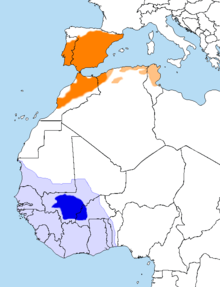Red-necked goat milker
| Red-necked goat milker | ||||||||||
|---|---|---|---|---|---|---|---|---|---|---|

Red-necked goat milker ( Caprimulgus ruficollis ) |
||||||||||
| Systematics | ||||||||||
|
||||||||||
| Scientific name | ||||||||||
| Caprimulgus ruficollis | ||||||||||
| Temminck , 1820 |
The red-necked nightjar ( Caprimulgus ruficollis ) is a species of bird from the family of the night swallows and off the nightjar , the second occurring in Europe kind of family. It is distributed in two subspecies in large parts of the Iberian Peninsula and in northern Magreb .
features
The red-necked nightjar is significantly larger than the spread in Central Europe nightjar . The body length is 30–34 cm, the wingspan 60–65 cm. The cryptic gray-brown drawing of the upper side with light bands and black lines is very similar to that of the goat milker. In contrast to this species, however, the collar, throat and front breast of the red-necked goat milker are finely banded in yellowish red. Furthermore, the species shows four bright, equally wide bands on the upper wings. Both sexes have white fields on the wing tips and on the outer edges of the tail (in the goat milker only the males). The sexes hardly differ; in adult males the white fields are more pronounced.
Vocalizations
During the mating season, the male sings persistently two-syllable cracking "kjutok-kjutok ..." especially during the twilight hours but also at night; Usually the singing is performed with clear pauses, but the tempo can increase so that it appears almost without any interval. The female calls out "Che-Che-Che ...". In addition, high-pitched, high-pitched calls can sometimes be heard, which are interpreted as alarm calls. During the courtship season, loud clapping of wings can occasionally be heard, often in connection with territorial disputes. The singing is performed either from a seat or in flight and can be heard well up to a distance of 400 meters.
distribution and habitat
The species has a relatively small range in the southwest of the Palearctic . In Europe, with the exception of north-west Spain and northern Portugal, it covers almost the entire Iberian Peninsula and, to the south, the coastal areas of North Africa from Morocco to Tunisia . The occurrences observed in the extreme south of France until the middle of the 20th century are likely to have been extinct.
The red-necked goat milker lives there on sandy heaths with bushes and pine forests with open, largely vegetation-free areas. Occasionally it also appears in more humid habitats, such as in eucalyptus plantations. The species occurs from sea level to altitudes of a little over 1000 meters. Little information is available about the space requirements of the species. A study carried out in southern Spain found on average one breeding pair per 18 hectares.
Subspecies
From the nominate form , the subspecies C. r. desertorum distinguished. It occurs in semi-arid habitats from northern Algeria east to Tunisia, perhaps also Libya . It is clearly paler in color, its ventral side looks silver-gray.
hikes
The species is a migratory bird and winters in western Africa south of the Sahara. Most of the reports of wintering red-necked goat milkers come from the Niger region of southern Malis . The breeding areas are reached from the end of April and left again towards the south from mid-October.
Food and subsistence
The red-necked goat milker feeds mainly on insects that are caught in flight. Occasionally he also collects easily accessible prey from the surface of the earth. It is possible that the species can keep insects captured during the flight in palm pockets and only swallow them later or feed them to the young. The gastric contents examined almost always contained gastroliths .
Red-necked goat milkers hunt in an almost silent flight with many turns, usually relatively close to the ground. Your activity time begins well after sunset and ends at early dawn. They are not infrequently associated with conspecifics, occasionally also with C. europaeus .
Breeding biology
The breeding season begins in late May and lasts until July. Even in August, fresh clutches were seldom found that were second or second clutches. The nest is a shallow dugout; it can be in the open or shaded under bushes. The clutch consists of two long-elliptical, light-gray eggs that have clear gray or yellowish-brown spots. Neither the incubation period nor the involvement of the partners in the hatchery are currently known. The young can leave the nest a few days after hatching to look for shade. They begin their first flight attempts at around 18 days of age. At 5–6 weeks they are independent from their parents.
Stock situation
Few surveys are available for the species. IUCN does not list them at any risk level and roughly estimates the total population at a maximum of 110,000 breeding pairs in Europe. After Holyoak, the species is common in Spain and Portugal. The distribution areas in northern Magreb have so far been little explored ornithologically, but even there the species does not seem to be rare.
literature
- Data sheet Birdlife
- David T. Holyoak & Martin Woodcock : Nightjars and their Allies . Oxford University Press 2001. pp. 472-479. ISBN 0-19-854987-3
- Lars Svensson , Peter J. Grant, Killian Mullarney, Dan Zetterström: The new cosmos bird guide. Kosmos, Stuttgart 1999, ISBN 3-440-07720-9 .
Web links
- Image of the red-necked goat milker
- Age and gender characteristics (PDF; 3.1 MB) by J. Blasco-Zumeta and G.-M. Heinze (Eng.)
- Caprimulgus ruficollis inthe IUCN Red List of Threatened Species 2013.2. Listed by: BirdLife International, 2012. Retrieved February 5, 2014.
- Feathers of the red necked goat milker

